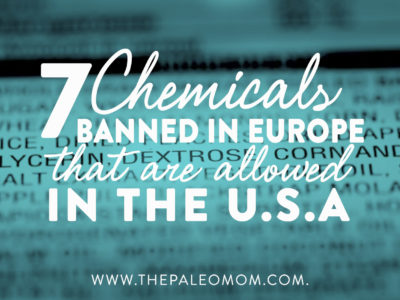Previously, we’ve looked at food ingredients that sound scary but aren’t, and that we shouldn’t fear just because they have unfamiliar names. On the flip side, there are a number of common chemicals we’re exposed to on a daily basis that we’re told are safe, but that might actually be toxic to the human body. In fact, hundreds of cosmetics, personal care products, and household cleaners sold in the US have ingredients that have been banned in other countries due to potentially acting as carcinogens, endocrine disruptors, neurotoxins, reproductive toxins, or skin, lung, or eye irritants (among other things!). In fact, the European Union has banned over 1,300 ingredients from cosmetic products alone, while the FDA has only banned or restricted 11. This isn’t to say every chemical on the EU’s list is definitely harmful at levels we’re typically exposed to, but the goal here is “better safe than sorry”—especially when we can choose alternative products with ingredients we’re more confident are nontoxic!
So, what should we look out for when buying products we use on our bodies or in our homes? Here’s a rundown of some ingredients we should steer clear of, all of which are banned by the European Commission but are still allowed in the US.
 Talc (or talcum powder) is a bulking and absorbent mineral that can sometimes contain asbestos, and has been linked to ovarian cancer, gynecological tumors, and mesothelioma (a rare cancer affecting the protective tissues covering the lungs and abdomen). Although talc is banned from use in cosmetic products in the European Union, it’s still used in some US products like baby powder, face powder, and deodorants.
Talc (or talcum powder) is a bulking and absorbent mineral that can sometimes contain asbestos, and has been linked to ovarian cancer, gynecological tumors, and mesothelioma (a rare cancer affecting the protective tissues covering the lungs and abdomen). Although talc is banned from use in cosmetic products in the European Union, it’s still used in some US products like baby powder, face powder, and deodorants.
 Coal tar is a carcinogenic byproduct of coal processing (typically associated with lung cancer, digestive tract cancer, kidney cancer, and bladder cancer), and its use in cosmetics is prohibited by the European Commission (although its use in the United States is still allowed). Coal tar is used in hair dyes, dandruff treatment, rosacea treatment, and some shampoos. What’s more, coal tar can contain other carcinogenic substances, such as polycyclic aromatic hydrocarbons (PAHs).
Coal tar is a carcinogenic byproduct of coal processing (typically associated with lung cancer, digestive tract cancer, kidney cancer, and bladder cancer), and its use in cosmetics is prohibited by the European Commission (although its use in the United States is still allowed). Coal tar is used in hair dyes, dandruff treatment, rosacea treatment, and some shampoos. What’s more, coal tar can contain other carcinogenic substances, such as polycyclic aromatic hydrocarbons (PAHs).
 Triclosan is used to prevent or reduce bacterial contamination, and has been linked to hormone disruption, immune system damage, the development of antibiotic-resistant germs, and potentially skin cancer (additional studies examining its potential toxicity are still underway). In 2016, the FDA banned triclosan from over-the-counter antiseptic products (like bar soaps, body washes, and liquid, gel, or foam hand soaps), but it’s still allowed in toothpaste (particularly Colgate Total).
Triclosan is used to prevent or reduce bacterial contamination, and has been linked to hormone disruption, immune system damage, the development of antibiotic-resistant germs, and potentially skin cancer (additional studies examining its potential toxicity are still underway). In 2016, the FDA banned triclosan from over-the-counter antiseptic products (like bar soaps, body washes, and liquid, gel, or foam hand soaps), but it’s still allowed in toothpaste (particularly Colgate Total).
 Butylated hydroxyanisole (BHA) is a potential endocrine disruptor and carcinogen, with possible links to organ system toxicity and reproductive toxicity. This compound is typically used as a preservative in personal care products (as well as in food), and is most common in hair products, lip products, makeup, sunscreen, fragrance, and antiperspirant and deodorant. Although the European Union has banned it from use in cosmetics, it can still be used in products sold in America.
Butylated hydroxyanisole (BHA) is a potential endocrine disruptor and carcinogen, with possible links to organ system toxicity and reproductive toxicity. This compound is typically used as a preservative in personal care products (as well as in food), and is most common in hair products, lip products, makeup, sunscreen, fragrance, and antiperspirant and deodorant. Although the European Union has banned it from use in cosmetics, it can still be used in products sold in America.
 Ethanolamines (including triethanolamine (TEA), diethanolamine (DEA), monoethanolamine (MEA), cocamide DEA, myristamide DEA, DEA-cetyl phosphate, DEA oleth-3 phosphate, lauramide DEA, oleamide DEA, TEA-lauryl sulfate diethanolamine, cocamide MEA, linoleamide MEA, and stearamide MEA) are linked to liver tumors and organ system toxicity, and when used in products that also contain certain preservatives, can form nitrosamines (a class of chemicals with carcinogenic potential). Despite being banned by the European Commission, ethanolamines are still found in products in the USA such as soaps, hair conditioner, hair dye, shampoo, shaving creams, mascara, eyeliner, eye shadow, blush, foundations, fragrances, household cleaning products, waxes, lotions, and sunscreen.
Ethanolamines (including triethanolamine (TEA), diethanolamine (DEA), monoethanolamine (MEA), cocamide DEA, myristamide DEA, DEA-cetyl phosphate, DEA oleth-3 phosphate, lauramide DEA, oleamide DEA, TEA-lauryl sulfate diethanolamine, cocamide MEA, linoleamide MEA, and stearamide MEA) are linked to liver tumors and organ system toxicity, and when used in products that also contain certain preservatives, can form nitrosamines (a class of chemicals with carcinogenic potential). Despite being banned by the European Commission, ethanolamines are still found in products in the USA such as soaps, hair conditioner, hair dye, shampoo, shaving creams, mascara, eyeliner, eye shadow, blush, foundations, fragrances, household cleaning products, waxes, lotions, and sunscreen.
Nutrivore Weekly Serving Matrix
An easy-to-use and flexible weekly checklist
to help you maximize nutrient-density.
The Weekly Serving Matrix is very helpful! I’ve been eating along these lines but this really helps me know where to focus vs. which foods serve a more secondary role. It’s super helpful and has taken a lot of worry out of my meal planning. Thanks!
Jan
 Phenacetin is human carcinogen (including being linked to malignant mammary tumors and renal pelvis tumors), and is also known to cause and anemia. Although this toxin was banned from most countries in the 1960s, it’s still used in some American products as a stabilizer in hair color, facial hair bleach, and hair-removal treatments.
Phenacetin is human carcinogen (including being linked to malignant mammary tumors and renal pelvis tumors), and is also known to cause and anemia. Although this toxin was banned from most countries in the 1960s, it’s still used in some American products as a stabilizer in hair color, facial hair bleach, and hair-removal treatments.
Methylisothiazolinone (MIT) is a common preservative with possible inhalation toxicity and neurotoxic effects. It is found in some brands of shampoo (including baby shampoo), hair color, conditioner, shaving cream, makeup remover, lotion, sunscreen, mascara, and hairspray. Recently, the European Commission received unanimous support to ban methylisothiazolinone as a preservative in leave-on cosmetic products (except at levels below 100 ppm), but this chemical is still allowed in items sold within the US.
is a common preservative with possible inhalation toxicity and neurotoxic effects. It is found in some brands of shampoo (including baby shampoo), hair color, conditioner, shaving cream, makeup remover, lotion, sunscreen, mascara, and hairspray. Recently, the European Commission received unanimous support to ban methylisothiazolinone as a preservative in leave-on cosmetic products (except at levels below 100 ppm), but this chemical is still allowed in items sold within the US.
In all, it’s well worth the extra time it takes to read ingredients labels (and seek out truly non-toxic products) for the sake of our long-term health. The Environmental Working Group (http://www.ewg.org) and the CDC’s National Institute for Occupational Safety and Health (http://www.cdc.gov/niosh/) have more exhaustive information on the many harmful chemicals lurking in everyday products. As with food, quality matters—even in personal care products, cosmetics, and cleaning supplies!
Citations
Antoni S, et al. “The ban on phenacetin is associated with changes in the incidence trends of upper-urinary tract cancers in Australia.” Aust N Z J Public Health. 2014 Oct;38(5):455-8.
Burnett CL, et al. “Final report of the safety assessment of methylisothiazolinone.” Int J Toxicol. 2010 Jul;29(4 Suppl):187S-213S.
Cosmetic Ingredient Review Expert Panel. “Final safety assessment of Coal Tar as used in cosmetics.” Int J Toxicol. 2008;27 Suppl 2:1-24
Dinwiddie MT, et al. “Recent Evidence Regarding Triclosan and Cancer Risk.” International Journal of Environmental Research and Public Health. 2014;11(2):2209-2217.
“EU Public Consultation on Methylisothiazolinone (MI) Ban for Leave-on Cosmetic Products Launched.” Chemical Inspection and Regulation Service. 11 May 2016.
Jong SH, et al. “Effects of butylated hydroxyanisole on the development and functions of reproductive system in rats.” Toxicology. 2005 Mar 1;208(1):49-62.
Labrador V, et al. “Cytotoxicity of butylated hydroxyanisole in Vero cells.” Cell Biol Toxicol. 2007 May;23(3):189-99.
Lehman-McKeeman LD, et al. “Diethanolamine induces hepatic choline deficiency in mice.” Toxicol Sci. 2002 May;67(1):38-45.
Marston CP, et al. “Effect of a complex environmental mixture from coal tar containing polycyclic aromatic hydrocarbons (PAH) on the tumor initiation, PAH–DNA binding and metabolic activation of carcinogenic PAH in mouse epidermis.” Carcinogenesis. 2001 Jul;22(7):1077-86.
Saito M, et al. “Cytotoxicity and apoptosis induction by butylated hydroxyanisole (BHA) and butylated hydroxytoluene (BHT).” Anticancer Res. 2003 Nov-Dec;23(6C):4693-701.
Shakoor A, et al. “Pulmonary talcosis 10 years after brief teenage exposure to cosmetic talcum powder.” BMJ Case Rep. 2011 Sep 19;2011.
Stott WT, et al. “Potential mechanisms of tumorigenic action of diethanolamine in mice.” Toxicol Lett. 2000 Apr 3;114(1-3):67-75.
van Huisstede A, et al. “Talcosis due to abundant use of cosmetic talcum powder.” Eur Respir Rev. 2010 Jun;19(116):165-8.
Yazdankhah SP, et al. “Triclosan and antimicrobial resistance in bacteria: an overview.” Microb Drug Resist. 2006 Summer;12(2):83-90.











